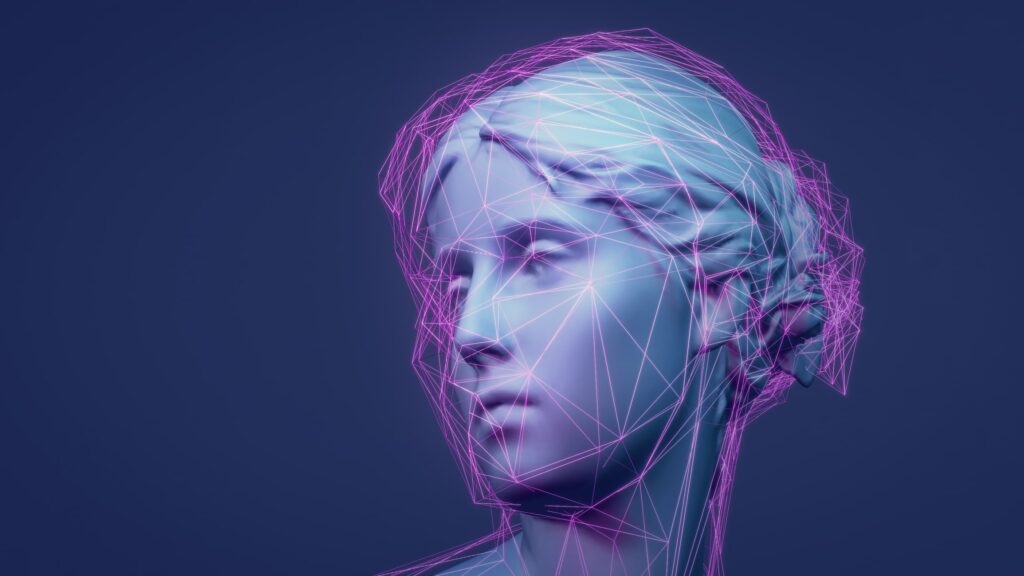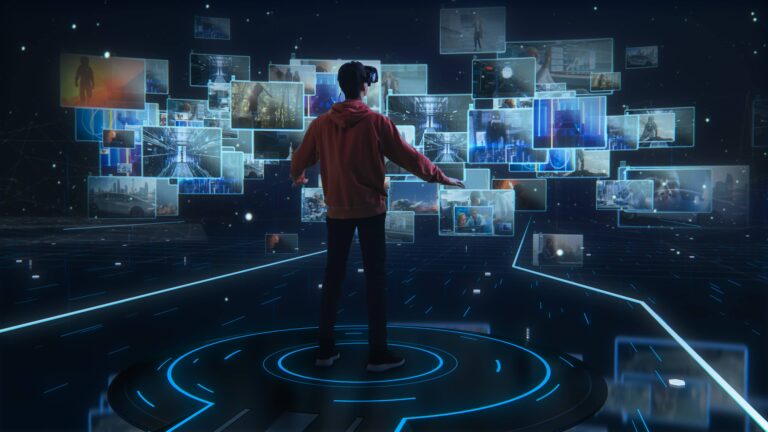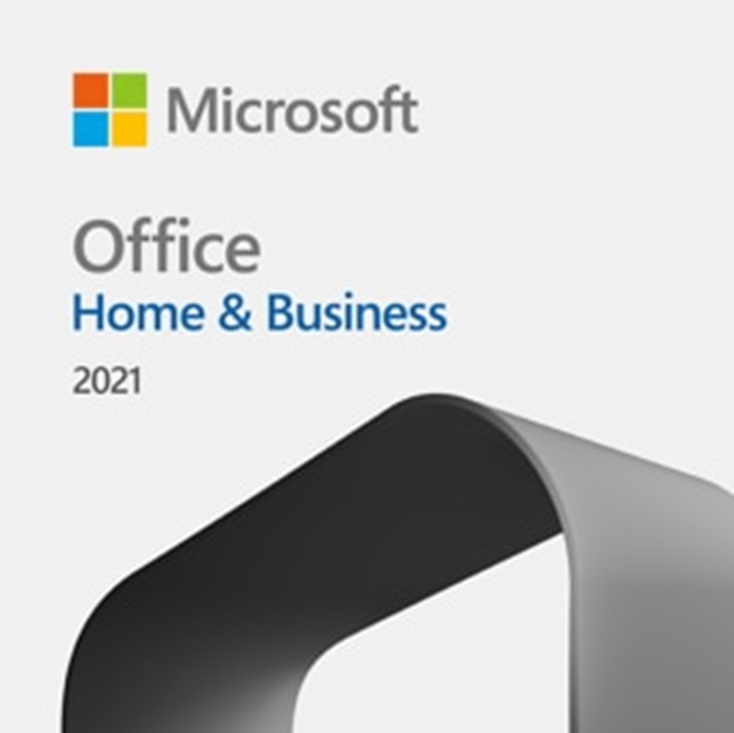
WebAR stands poised to converge our physical and digital worlds into a fusion of augmented awesomeness.
In this epic byte-filled journey, we’ll digitally spelunk into the caverns of what WebAR is, how it works, and why businesses are lining up to jump on the WebAR. We’ll spotlight real-world WebAR pioneers, showing us glimpses of the future.
So, sync your senses, calibrate your consciousness, and let’s dive down the WebAR The future beckon.
Table of Contents
What Is WebAR?
Web-based augmented reality technology and the related augmented reality, commonly referred to as WebAR, allows users to experience augmented reality content directly through a web browser without installing a separate mobile browser and app. WebAR relies on standard web technologies like HTML, CSS, and JavaScript to deliver augmented reality experiences, with additional JavaScript libraries and APIs to tap into native device capabilities.
At its core, WebAR involves displaying virtual content overlaid onto views from a device’s camera, creating a view of the real world supplemented by computer-generated graphics and information. The integration happens in real-time, anchored to the physical environment the user is looking at through their device’s camera. For example, a WebAR experience could overlay a 3D furniture model onto a live camera view of a room to see how it would look in space.

Under the hood, Web-based augmented reality relies on technologies like ORBSLAM for visual localization and mapping real-world environments. It also leverages semantic segmentation and neural networks to understand what objects and surfaces are in the camera view. But all this computer vision processing happens behind the scenes – end users visit a website and immediately see augmented reality content anchored to their surroundings.
The key advantage of WebAR is it removes friction by delivering augmented reality experiences instantly through browsers. Users don’t have to install apps, potentially wait for downloads, grant invasive permissions, or sacrifice storage space. Developers also don’t have to deal with app store publishing processes and can update WebAR content dynamically like any webpage. Overall, WebAR aims to make augmented reality more accessible and frictionless for users and developers.
While native mobile apps still have advantages in performance and camera access, rapid web technology improvements have enabled WebAR experiences that approach native quality. WebAR continues to gain new capabilities like the occlusion of virtual objects by real-world surfaces, cross-device experiences, and multi-user shared AR scenes. With WebAR, the Web remains a compelling platform for delivering augmented reality to consumers. It removes barriers to entry and leverages web infrastructure people already use daily. As augmented reality goes mainstream, expect WebAR technologies to help drive adoption across desktop and mobile browser experiences.
Key WebAR Capabilities
Environment Tracking: WebAR uses advanced computer vision techniques like point clouds, feature detection, and surface mapping to understand physical environments and track the camera’s position relative to real-world surfaces and objects. This allows anchoring virtual objects so they remain fixed as you move around.
Plane and Surface Detection: By detecting horizontal, vertical, and angled surface planes in the camera view, WebAR can place virtual objects atop tables, floors, walls, and inclined surfaces seamlessly.
Lighting Estimation: WebAR can estimate real-world lighting, enabling virtual objects to reflect and react to actual lighting conditions with convincingly realistic shadows and highlights.
3D Object Rendering: WebAR leverages the graphics processing power of modern devices and browsers to render detailed interactive 3D models smoothly integrated into real-world scenes.
Web-based augmented reality offers a framework to deliver augmented reality experiences through websites and browsers without separate apps. It tracks environments, detects surfaces, estimates lighting, and renders interactive 3D content anchored into real-world camera views – all happening live in the browser.
How WebAR Works?
The key enabling technology for bringing AR capabilities into web browsers is WebXR. WebXR provides JavaScript APIs for accessing virtual and augmented reality hardware features like stereoscopic displays, room-scale tracking, controllers, and environmental sensing.

With WebXR support, websites can tap into these device capabilities to understand and map physical environments, locating the viewer’s perspective within the space. This allows the rendering of virtual objects mixed into the web page using the real-world view from the device’s camera.
When visiting a website with WebAR, here is what’s generally happening behind the scenes:
- The website requests access to the device’s camera, motion sensors, light sensor, and location data via WebXR.
- The browser begins streaming live video feeds from the device’s camera.
- Each video frame is analyzed using computer vision to map the environment and track the camera’s position and orientation within the space.
- Virtual 3D models are rendered from the camera’s perspective with coordinates anchored to real-world surfaces and objects.
- The virtual overlays are composited into the live video stream to create an augmented reality view blending real and digital.
- This combined augmented video gets streamed back and displayed on the device screen as the user moves around.
- Steps 3-6 repeat continuously, keeping the virtual content locked into the environment as the camera perspective changes in real-time.
In essence, the Web-based technology for augmented reality uses WebXR to access device sensors, process the camera input, overlay virtual objects that respond to environmental tracking and lighting, and return an augmented video stream, all happening live in the browser.
How is WebAR Different from App-Based AR?
Previously, most AR experiences lived in dedicated mobile apps built with native platforms like ARCore for Android and ARKit on iOS. These apps rely on similar concepts as the popular WebAR frameworks – performing environmental mapping, surface detection, camera tracking, and overlaying interactive 3D assets.
But native app AR required downloading and installing a separate application from an app store. This created friction through app discovery, downloads, updates, platform fragmentation, and lack of web integration.
In contrast, the WebAR solution delivers AR experiences directly through web browsers without needing any apps. Some key WebAR advantages include:
- Instant access by clicking a link or loading any WebAR-enabled site. No installation is required.
- Consistent cross-platform AR on mobile devices and desktops rather than platform-dependent apps.
- Automatic updates as websites evolve. No need to download app updates.
- Findable through search engines enabling viral spread. App AR is walled off.
- Lightweight assets loaded on-demand instead of downloading large apps.
- Multi-user AR via shared browser links enabling social WebAR.
- Seamless integration with existing web content, sites, and workflows.
So, WebAR lowers friction through instant cross-device access, built-in discovery, automatic updates, and lightweight delivery while opening unique multi-user and web integration possibilities.
Why WebAR? Benefits of WebAR for Businesses
For enterprises exploring AR solutions, WebAR unlocks some compelling advantages over app-based approaches:
Viral spread: WebAR experiences can proliferate rapidly via shareable links across social media and websites, expanding the reach of the target audience.
Instant access: Since WebAR works across all modern mobile browsers and devices, users can instantly jump into experiences without prerequisites.
Fresh content: New Web-based augmented reality experiences can be published and updated instantly without app release cycles.
Built-in analytics: Web analytics provide detailed insights into WebAR performance and user interactions.
SEO visibility: WebAR content surfaces in search results, enabling organic discovery. The app’s AR content is hidden.
Scalability: WebAR seamlessly scales across audiences without app install hurdles or platform limits.
Cross-device: WebAR technology provides consistent Web-based AR experience on mobiles and desktops rather than fragmented native apps.
Lightweight: With no large apps to download, WebAR is ideal for bandwidth-constrained mobile usage.
Commerce: WebAR drives conversions through virtual product previews and try-ons.
So for businesses, Web-based augmented reality unlocks viral reach, frictionless access, frequently updated content, analytics, SEO, scalability, cross-device delivery, and lean bandwidth usage – making it easy to drive brand engagement.
What are the Use Cases for WebAR?

With the ability to composite virtual objects into our physical environments, WebAR opens an expansive palette for brands and businesses. Major current and emerging WebAR use cases include:
Marketing – Immersive WebAR brand experiences embedded in websites, social media, and ads let users interactively engage with products and campaigns.
Retail – Virtual try-ons and previews that enable assessing products, configurations, and fit realistically for shopper confidence.
Training – Workplace skills development and equipment operation proficiency through safe WebAR simulations of hazardous scenarios.
Education – Next-gen learning through WebAR models of anatomical structures, chemical reactions, historical artifacts, and astronomical bodies.
Gaming – Blending real-life environment in-world environments into WebAR gameplay using mobiles as AR portals for overlaid narratives and challenges.
Events – Attendees can access Web-based augmented reality schedules, wayfinding, networking, polls, and shareable social media moments.
Tourism – Enriched travels through WebAR translations, historic overlays, art discovery, and city exploration.
Navigation – Turn-by-turn walking directions overlaid onto real-time camera views rather than small maps.
Visualization – WebAR data visualization blends abstract datasets with physical environments for tangible insights.
Design – Home decor apps enable virtual staging furnishings and finishes to preview options.
Assistive – Advanced WebAR apps can guide medical procedures, industrial workflows, equipment repairs, and other hands-on tasks.
As augmented reality gains adoption, we’ll see WebAR become a standard experience layer augmenting websites and core mobile browsers and apps with contextually relevant virtual enhancements. WebAR has huge potential for learning, collaboration, navigation, visualization, and assisting skilled real-world activities.
WebAR Examples
Web AR refers to augmented reality experiences accessible directly through a web browser without needing a separate mobile app download. Here are some leading examples of innovative Web AR implementations:
ViewToo's Face Mask Guide
ViewToo developed an educational WebAR experience focused on proper face mask-wearing techniques. Users could launch animated guides by scanning a code demonstrating correct mask usage. Given COVID-19 health concerns, ViewToo creatively leveraged AR technology to spread an important public health message.
The WebAR-based mask guides reached a broad audience with compelling, interactive content. The initiative promoted public safety during the pandemic. According to ViewToo’s CEO, this AR experience represented a contribution to society in difficult times.
Huggies' WebAR Marketing Campaign by Queppelin
Queppelin helped Huggies launch a new product line in Malaysia leveraging Web AR technology. Customers could view virtual representations of the diapers by scanning QR codes placed on Huggies’ website, in retail stores, and on product packaging. Separate QR codes enabled tracking of consumer behavior before and after purchase.
In addition to virtual diaper viewing, customers could also obtain gift vouchers via the Web AR experience. Overall, the novel Web AR-powered marketing campaign achieved an 8% conversion rate and a 3X increase in conversion value for Huggies. The accessibility and convenience of Web AR proved highly effective.
Universal's "Trolls World Tour" Promotion
Universal Pictures collaborated with Zappar on a WebAR promotion for the movie Trolls World Tour. Advanced world tracking capabilities allowed them to overlay a detailed map of the Trolls kingdom into users’ real physical environments. As users moved their phone camera, the virtual map adjusted accordingly.
The Web AR experience also gave users access to fun branded face filters matching the Troll’s characters’ iconic hair and outfits. This interactive campaign created unparalleled engagement, allowing Universal to promote the film across a broad audience. The use of WebAR removed friction from accessing the experience.
Coca-Cola’s #RefreshWhereVs
For a branding campaign named #RefreshWhereVs, Coca-Cola collaborated with Zappar on an engaging WebAR experience. Users scanned printed codes on Coca-Cola cans to unlock AR face filters. Additional filters became accessible through repeat purchases, incentivizing engagement. Rather than requiring an app download, the immersive effects were launchable directly from the code scan.
The WebAR technology helped bring Coca-Cola’s campaign to life in a fun, interactive way. And without the friction of a separate app install. Overall, forward-thinking WebAR integration is enabling next-level immersive marketing.
Black & Decker's 3D AR Business Cards
3D AR business cards offer a forward-thinking WebAR update to traditional cards. Users scan a QR code on the back of the card to launch a URL. Pointing their phone camera at the card then triggers an interactive 3D animation of the card.
The AR experience also includes clickable social media icons that float above the card. This enables engagement monitoring, seeing which buttons get clicked most often. The business cards leverage WebAR for a smooth merging of offline and online. Remarketing ads can even target people who scanned the card.
These examples showcase Web AR’s expanding role in immersive marketing and engagement. By removing app download requirements, WebAR enables smoother user access to augmented brand experiences. As the technology advances further, WebAR adoption will continue growing across industries. The above examples highlight innovative ways top brands have already begun integrating WebAR for captivating promotions.
The Road Ahead for WebAR
While still early days, rapid WebAR advances hint at truly transformative potential futures:
Shared Spaces – Multi-user shared live WebAR spaces for social gatherings, events, collaborative design, and hybrid in-person/virtual meetings.
Photorealism – Ray-tracing, light-field simulation, and AI rendering will unlock virtual objects and characters indistinguishable from augmented reality technologies.
World Understanding – Spatial AI understanding of real-world geometry, materials, lighting, acoustics, textures, physics, and object relationships enables highly realistic mixed reality experiences.
Natural Interaction – Intuitive inputs like gaze, gestures, and voice, along with body/hand/eye/face tracking, will enable seamless WebAR control. Shared virtual collaborators could assist in our environments.
Cross-Reality – WebAR experiences will blend seamlessly with VR, giving users mixed-reality powers to transcend worlds fluidly.
As networks, sensors, and graphics exponentially evolve, today’s fixed virtual overlays will transform into full-fidelity environments, blending physically and digitally into one fluid experiential mesh indistinguishable from reality.
Conclusion
For consumers, the AR platform promises to eliminate guesswork and disappointment by enabling virtually trying anything first. Shopping, learning, traveling, and connecting could all transform through contextually relevant WebAR overlays.
For innovators, WebAR offers a new creative medium enabling completely new genres of experiences blending real and virtual. The opportunity exists to build the persistent layered digital worlds people will inhabit in the future.
For enterprises, embracing WebAR early promises to drive brand engagement, mindshare, and affinity while uncovering new opportunities for value creation. Organizations that wait for risk creative disruption.
The dawn of exponential technological change brings disruption but also immense opportunities to delight customers in new ways while moving society forward. The augmented reality revolution has arrived on the Web. The time for action is now!
Will we build worlds that expand human potential? The choice is ours. The future beckons. Let the WebAR era begin.
Frequently Asked Questions (FAQs)
Here are answers to frequently asked questions about WebAR:
What web browsers support WebAR?
Major browsers with WebAR technology support today include:
- Chrome for Android
- Safari for iOS
- Firefox Reality on Android
- Oculus Browser
- Edge Reality Browser
Desktop Chrome and Firefox will gain built-in WebAR abilities soon. Opera, Samsung Internet, and others are adding support.
What hardware works for WebAR?
You need a mobile device or headset with these features:
- Rear-facing camera
- Motion & position sensors
- Capable processor (recent midrange or better)
- WebXR compatible browser
For desktop WebAR, you need a Windows PC with a web camera and a supported browser. Mac support is in development.
How can I create WebAR experiences?
Popular WebAR development platforms:
- Three.js
- A-Frame
- AR.js
- Reality Composer
- Spark AR Studio
- 8th Wall
- Amazon Sumerian
- Unity
There are also online creation tools like Thunkable, Metaverse, and Builder.io.
How will WebAR evolve in the future?
Upcoming WebAR technology capabilities that will expand possibilities:
- Shared multi-user AR spaces
- Photorealistic rendering
- AI-powered world understanding
- Eye tracking and face/hand tracking
- Cross device experiences blending AR, VR, and mobile
- 5G connectivity enabling lightweight glasses
As technology improves, real and virtual worlds blend into one dynamic, persistent environment anchored everywhere around us.
Does WebAR work for creating mobile apps?
Yes, Web AR technology can be built into native iOS and Android apps using browser rendering engines like Chromium (Android) and WKWebView (iOS) to deliver full-featured native AR+ experiences.
Are there privacy concerns with WebAR?
As with websites, users must opt-in to grant those creating WebAR experiences access to device sensors and data. Transparent permission handling and thoughtful data practices are important for earning user trust.
The technology underpinning Web AR technology offers immense creative possibilities but must prioritize user agency, privacy, and ethics above all else. Our collective values must guide how we wield these powerful new tools.

